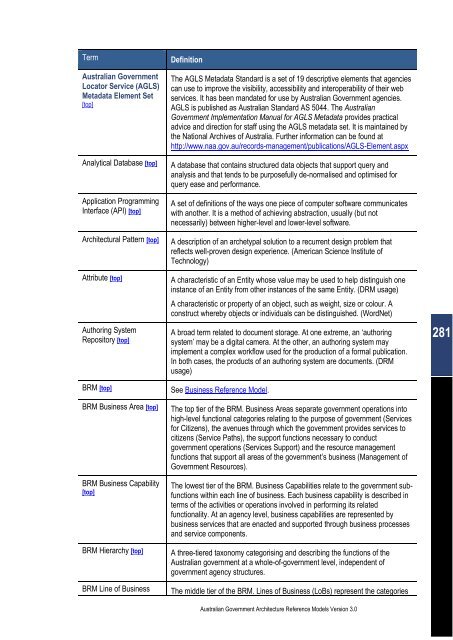Australian Government Architecture Reference Models Version 3.0
Australian Government Architecture Reference Models Version 3.0
Australian Government Architecture Reference Models Version 3.0
Create successful ePaper yourself
Turn your PDF publications into a flip-book with our unique Google optimized e-Paper software.
Term Definition<br />
<strong>Australian</strong> <strong>Government</strong><br />
Locator Service (AGLS)<br />
Metadata Element Set<br />
[top]<br />
The AGLS Metadata Standard is a set of 19 descriptive elements that agencies<br />
can use to improve the visibility, accessibility and interoperability of their web<br />
services. It has been mandated for use by <strong>Australian</strong> <strong>Government</strong> agencies.<br />
AGLS is published as <strong>Australian</strong> Standard AS 5044. The <strong>Australian</strong><br />
<strong>Government</strong> Implementation Manual for AGLS Metadata provides practical<br />
advice and direction for staff using the AGLS metadata set. It is maintained by<br />
the National Archives of Australia. Further information can be found at<br />
http://www.naa.gov.au/records-management/publications/AGLS-Element.aspx<br />
Analytical Database [top] A database that contains structured data objects that support query and<br />
analysis and that tends to be purposefully de-normalised and optimised for<br />
query ease and performance.<br />
Application Programming<br />
Interface (API) [top]<br />
A set of definitions of the ways one piece of computer software communicates<br />
with another. It is a method of achieving abstraction, usually (but not<br />
necessarily) between higher-level and lower-level software.<br />
Architectural Pattern [top] A description of an archetypal solution to a recurrent design problem that<br />
reflects well-proven design experience. (American Science Institute of<br />
Technology)<br />
Attribute [top] A characteristic of an Entity whose value may be used to help distinguish one<br />
instance of an Entity from other instances of the same Entity. (DRM usage)<br />
Authoring System<br />
Repository [top]<br />
A characteristic or property of an object, such as weight, size or colour. A<br />
construct whereby objects or individuals can be distinguished. (WordNet)<br />
A broad term related to document storage. At one extreme, an ‘authoring<br />
system’ may be a digital camera. At the other, an authoring system may<br />
implement a complex workflow used for the production of a formal publication.<br />
In both cases, the products of an authoring system are documents. (DRM<br />
usage)<br />
BRM [top] See Business <strong>Reference</strong> Model.<br />
BRM Business Area [top] The top tier of the BRM. Business Areas separate government operations into<br />
high-level functional categories relating to the purpose of government (Services<br />
for Citizens), the avenues through which the government provides services to<br />
citizens (Service Paths), the support functions necessary to conduct<br />
government operations (Services Support) and the resource management<br />
functions that support all areas of the government’s business (Management of<br />
<strong>Government</strong> Resources).<br />
BRM Business Capability<br />
[top]<br />
The lowest tier of the BRM. Business Capabilities relate to the government subfunctions<br />
within each line of business. Each business capability is described in<br />
terms of the activities or operations involved in performing its related<br />
functionality. At an agency level, business capabilities are represented by<br />
business services that are enacted and supported through business processes<br />
and service components.<br />
BRM Hierarchy [top] A three-tiered taxonomy categorising and describing the functions of the<br />
<strong>Australian</strong> government at a whole-of-government level, independent of<br />
government agency structures.<br />
BRM Line of Business The middle tier of the BRM. Lines of Business (LoBs) represent the categories<br />
<strong>Australian</strong> <strong>Government</strong> <strong>Architecture</strong> <strong>Reference</strong> <strong>Models</strong> <strong>Version</strong> <strong>3.0</strong><br />
281

















